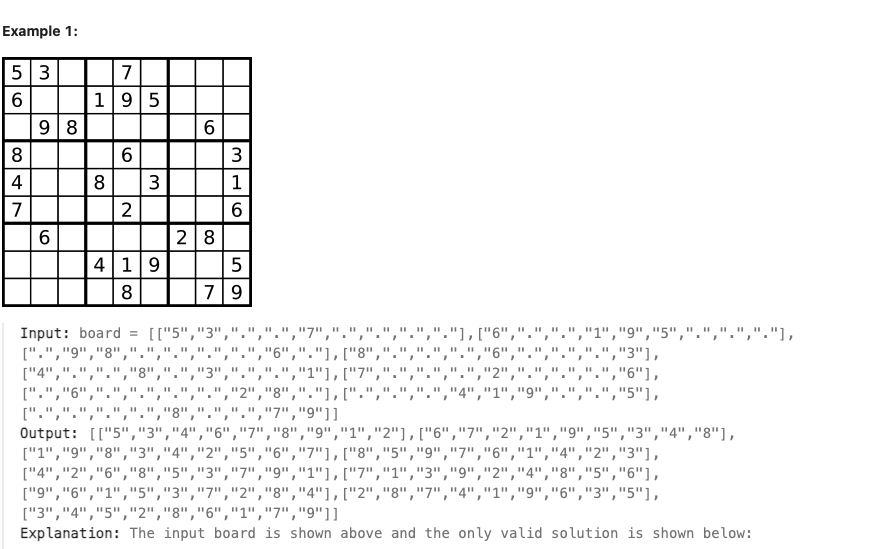Sudoku solver - two solutions from stupid to optmized one
PROBLEM
Write a program to solve a Sudoku puzzle by filling the empty cells.
A sudoku solution must satisfy all of the following rules:
Each of the digits 1-9 must occur exactly once in each row. Each of the digits 1-9 must occur exactly once in each column. Each of the digits 1-9 must occur exactly once in each of the 9 3x3 sub-boxes of the grid. The '.' character indicates empty cells.

Solution 1: Original Approach (Brute Force Backtracking)
Approach
- Backtracking algorithm:
- Traverse the board cell by cell and row by row.
- For each empty cell ('.') check if any number from ('1' to '9') is valid to place in the board through following restrict:
- Row Check: Ensure the number isn't already in the current row.
- Column Check: Ensure the number isn't already in the current column.
- Subgrid Check: Ensure the number isn't already in the current 3x3 subgrid.
- If valid, place the number and move to the next cell (recursive call).
- If a number placement leads to a valid solution, return True.
- If no number works, backtrack by resetting the cell to '.'.
- Base Case: If row == 9, all rows have been processed, and the solution is complete.
- Recursive Step: If col == 9, move to the next row (row + 1, col = 0).
Complexity
- Time complexity: O(9^81)
- There are 81 cells, and each can have 9 possible numbers in the worst case.
- However, pruning via is_valid reduces the number of possibilities significantly.
- Space complexity: O (81)
Code
class Solution:
def solveSudoku(self, board: List[List[str]]) -> None:
def is_valid(row:int, col: int, num):
#CHECK ROW
for i in range(9):
if board[row][i] == num:
return False
if board[i][col] == num:
return False
if board[3*(row//3) + i//3][3*(col//3) + i%3] == num:
return False
return True
def backtrack(row, col):
if row == 9:
return True
if col == 9: # increase row to 1 and reset col
return backtrack(row+1, 0)
if board[row][col] == '.':
for i in '123456789':
if is_valid(row,col, i):
board[row][col] = i
if backtrack(row, col+1):
return True
else:
board[row][col] = '.'
return False
else:
return backtrack(row, col+1)
backtrack(0,0)
Solution 2: Optimized Approach (Using Sets)
Initiation:
- Follow the solution1
- Instead using three lists of sets to track used number instead of check check valid position every time.
Complexity
- Time complexity: $$O(9^m)$$ - m is number of empty cells
- Space complexity: O(81)
Code
class Solution:
def solveSudoku(self, board: List[List[str]]) -> None:
rows = [set() for _ in range(9)]
cols = [set() for _ in range(9)]
boxes = [set() for _ in range(9)]
# Initialize sets with existing board values
for r in range(9):
for c in range(9):
if board[r][c] != ".":
rows[r].add(board[r][c])
cols[c].add(board[r][c])
boxes[3 * (r // 3) + c // 3].add(board[r][c])
def is_valid(r, c, num):
return (
num not in rows[r]
and num not in cols[c]
and num not in boxes[(r // 3) * 3 + c // 3]
)
def backtracking(row, col):
if row == 9:
return True
if col == 9:
return backtracking(row + 1, 0)
if board[row][col] == ".":
for i in "123456789":
if is_valid(row, col, i):
board[row][col] = i
rows[row].add(i)
cols[col].add(i)
boxes[3 * (row // 3) + col // 3].add(i)
if backtracking(row, col + 1):
return True
board[row][col] = "."
rows[row].remove(i)
cols[col].remove(i)
boxes[3 * (row // 3) + col // 3].remove(i)
return False
else:
return backtracking(row, col + 1)
backtracking(0, 0)
All rights reserved